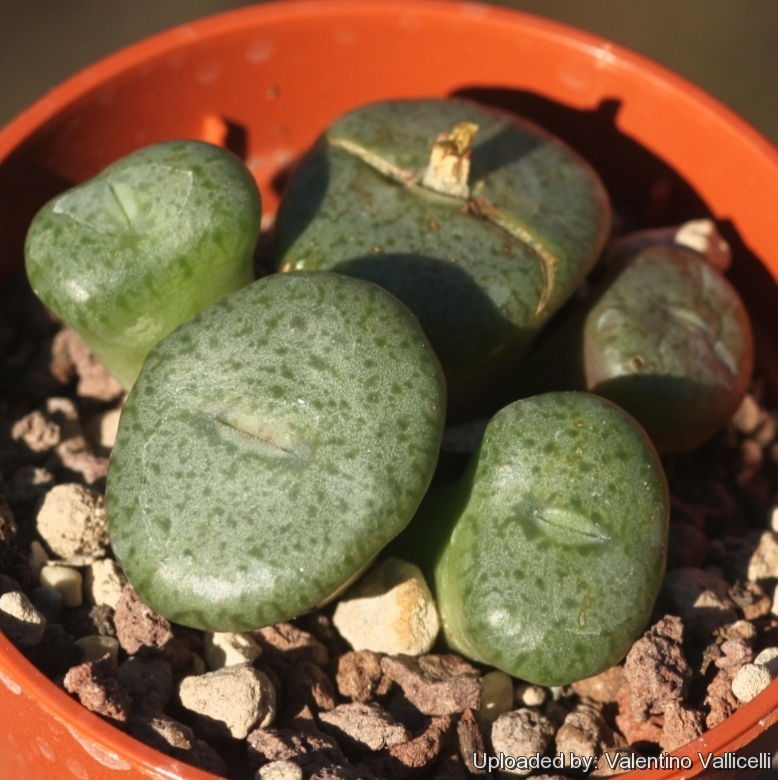Donate now to support the LLIFLE projects.
Your support is critical to our success.
Your support is critical to our success.

Conophytum obcordellum var. ceresianum Photo by: Valentino Vallicelli
Synonyms:
- Conophytum obcordellum var. ceresianum (L. Bolus) S.A.Hammer
- Conophytum ceresianum L. Bolus
See all synonyms of Conophytum obcordellum
back
Accepted name in llifle Database:Conophytum obcordellum var. ceresianum (L. Bolus) S.A.Hammer
Gen. Conophytum 235. 1993
Synonymy: 4
- Conophytum obcordellum var. ceresianum (L. Bolus) S.A.Hammer
- Conophytum ceresianum L. Bolus
- Conophytum ceresianum var. divergens (L. Bolus) Rawé
- Conophytum divergens L. Bolus
Conophytum obcordellum (Haw.) N.E.Br.
Gard. Chron. 1922, Ser. III. lxxi. 307.
Synonymy: 34
- Conophytum obcordellum (Haw.) N.E.Br.
- Conophytum creperum N.E.Br.
- Conophytum giftbergense Tischer
- Conophytum klaverense N.E.Br.
- Conophytum lambertense Schick & Tischer
- Conophytum lambertense var. conspicuum Rawé
- Conophytum longifissum Tischer
- Conophytum nevillei (N.E.Br.) N.E.Br.
- Mesembryanthemum nevillei N.E.Br.
- Conophytum obconellum (Haw.) Schwantes
- Conophytum obcordellum f. declinatum (Haw.) N.E.Br.
- Conophytum declinatum L. Bolus
- Conophytum obcordellum var. germanum (N.E.Br.) Rawé
- Conophytum germanum N.E.Br.
- Conophytum obcordellum f. multicolor (Tischer) Tischer
- Conophytum multicolor Tischer
- Conophytum obcordellum var. mundum (N.E.Br.) Rawé
- Conophytum mundum N.E.Br.
- Conophytum obcordellum var. parvipetalum (N.E.Br.) Tischer
- Conophytum parvipetalum (N.E.Br.) N.E.Br.
- Mesembryanthemum parvipetalum N.E.Br.
- Conophytum obcordellum f. picturatum (N.E.Br.) Tischer
- Conophytum obcordellum var. mundum f. picturatum (N.E.Br.) Rawé
- Conophytum picturatum N.E.Br.
- Conophytum obcordellum f. stayneri (L. Bolus) Rawé
- Conophytum obcordellum var. mundum f. stayneri (N.E.Br.) Rawé
- Conophytum ursprungianum var. stayneri L. Bolus
- Conophytum parviflorum N.E.Br.
- Conophytum parviflorum var. impressum (Tischer) Tischer
- Conophytum impressum Tischer
- Conophytum spectabile Lavis
- Conophytum ursprungianum Tischer
Conophytum obcordellum subs. rolfii (de Boer) S.A.Hammer
Gen. Conophytum 260. 1993
Synonymy: 3
- Conophytum obcordellum subs. rolfii (de Boer) S.A.Hammer
- Conophytum lambertense var. rolfii (de Boer) Rawé
- Conophytum rolfii de Boer
Conophytum obcordellum subs. stenandrum (L. Bolus) S.A.Hammer
Gen. Conophytum 263. 1993
Synonymy: 2
- Conophytum obcordellum subs. stenandrum (L. Bolus) S.A.Hammer
- Conophytum stenandrum L. Bolus
back
| Your Actions | |
|---|---|
| Back to Conophytum index | |
| Back to Aizoaceae index | |
 |
Back to Succulents Encyclopedia index |









